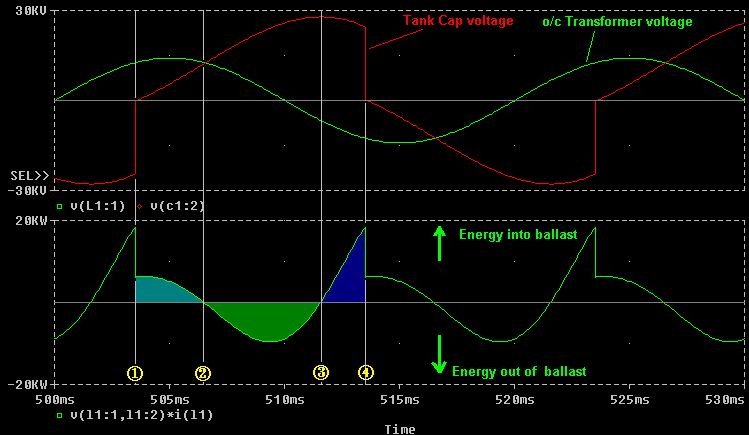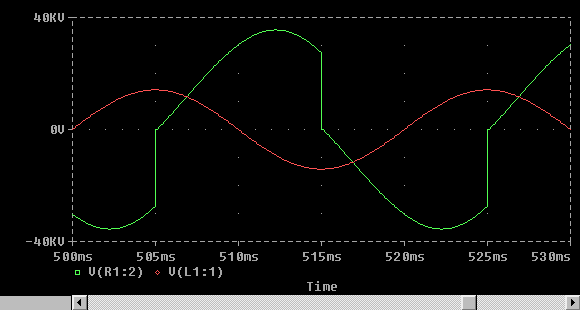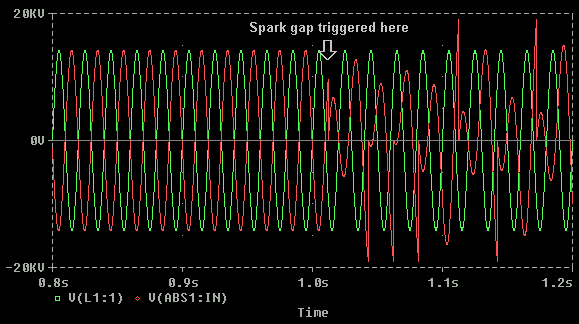In charging circuits with inductive ballasting and a spark gap, the inductive kick effect can increase the level to which the tank capacitor charges. This arises because of the inductors ability to store energy which would otherwise be dissipated as heat in a resistive ballast. The stored energy is then released some time later in the charging cycle.
Below is an example which shows the inductive kick effect with a 10kv/200mA/50Hz inductively ballasted supply and a 100BPS synchronous rotary spark gap system. The tank capacitor was chosen to be twice the "Matched" value so that no resonant voltage rise occurs. (See section on Resonant Charging.)
The top graph shows the normal open circuit transformer voltage (in GREEN) and the capacitor voltage (in RED.) The bottom graph shows the power flow into and out of the inductor.

At time 1 the tank capacitor is fully discharged by the previous firing of the spark gap. Vc=0, Vb=Vs.
|
|
Between time 1 and time 2 the output voltage of the transformer (in GREEN) is higher than the capacitor voltage (RED) Vs>Vc. The voltage across the ballast inductor is equal to Vs-Vc, so a current begins to flow through the inductor and charges the tank capacitor. During this time, current is flowing into the positive end of the ballast inductor, therefore power is flowing into the inductor and energy is being stored here. The light blue area of the graph represents the energy being stored in the inductor. The capacitor voltage gradually increases as it charges. |
At time 2 the capacitor voltage becomes equal to the output voltage of the transformer, Vc=Vs, and the voltage across the ballast inductor is zero for an instant Vb=0. However, current is still flowing in the ballast because the current through an inductor cannot change instantaneously.
|
|
Between time 2 and time 3 the stored energy in the ballast is released. In order to do this the voltage across the ballast changes its polarity. Current is now flowing out of the positive end of the inductor. This current continues to charge the tank capacitor to a voltage in excess of the transformer output voltage. The capacitor voltage goes higher than the transformer voltage because the voltage across the ballast inductor adds to the transformer voltage. Vc=Vs+Vc The energy released by the ballast is represented by the dark green area of the graph. |
At time 3 all of the stored energy in the ballast has been released and the tank capacitor is at its maximum voltage. At this point the inductor current is zero, but the capacitor voltage is higher than the transformer output voltage Vc>Vs so a voltage exists across the ballast inductor. Vb=Vc-Vs
|
|
Between time 3 and time 4 the capacitor starts to discharge back into the ballast inductance. The capacitor voltage begins to fall as current flows out of the tank capacitor. The capacitor is now acting as a source and energy is being pushed into the ballast inductor again. The dark blue area represents the energy which is transferred from the tank capacitor back into the ballast inductor. |
At time 4 the spark gap fires transferring all the energy from the tank capacitor to be Tesla Coil primary winding. The capacitor is rapidly discharged. The ballast voltage rapidly changes direction and equals the full output voltage of the transformer. Vc=0 and Vb=Vs
The whole cycle now begins again for the negative half cycle of the supply. (The current is already flowing in the correct direction.)
At first sight it would appear that the energy transfer from the charged tank capacitor back to the ballast inductor (dark blue area between 3 and 4) is undesirable, because it causes the capacitor voltage to drop. However, with more careful examination it can be seen that the energy transferred back to the ballast in this time is released to the tank capacitor in the next charging cycle so no power is wasted in the long term.
|
Energy into ballast inductor |
Energy out of ballast inductor |
|
Dark blue area + Light blue area = |
Dark green area |
With a synchronous rotary spark gap the firing point can be advanced in order to minimise the energy transferred back to the ballast between time 3 and 4. However, this results in an lower overall firing voltage. If this energy is not transferred back to the ballast the peak capacitor voltage at the end of the next charging cycle is significantly lower.
In summary, the charging system goes through 6 states during one entire cycle of the AC supply voltage:
[spark gap fires here]
[spark gap fires here]
The Inductive kick effect can be used to best effect with a synchronous rotary spark gap because the time at which the spark gap fires can be adjusted to obtain the desired voltage gain (and power throughput.) The graph below shows the effect of adjusting the point at which the sync rotary fires. The normal open-circuit voltage of the ballasted power supply is shown in RED, and the capacitor voltage waveform is in GREEN. The simulation was repeated with all possible rotary phase settings, and an animation was formed. (Ignore the scrollbar at the bottom, it does not do anything.)

The rotary firing time ranges from 0ms to 10ms after the supply voltage zero crossing point. When the rotary gap fires 5ms after the supply zero crossing, the inductive kick effect is maximised, and the highest firing voltage is produced in this particular example. This setting gives the best spark output from the Tesla Coil system.
Firing earlier than 5ms results in progressively less inductive kick effect as little energy is being stored in the inductive ballast.
Firing later than 5ms results in greater energy storage in the ballast but reduces the benefit from the inductive kick effect as progressively more energy is transferred from the tank capacitor back to the ballast before the spark gap fires. This energy transfer results in a high peak capacitor voltage, but causes a considerable "dive" in voltage just before the spark gap fires.
Please note that the timings mentioned here are unique to this example and depend on the relative values of the ballast inductor and tank capacitor.
(Also note that the continuously changing rotary phase shown in the animation above represents what happens if an asynchronous induction motor is used to drive a 100BPS rotary spark gap. In practice the motor shaft turns at slightly less than synchronous speed, and the firing point of the spark gap falls slightly later each time it fires. This produces the gradual "surging" which is visible.)
The above example is for a system using a rotary spark gap, however the same effect exists in any LC charging system to a varying degree.. Since the inductive kick effect relies on energy stored in the ballast, a voltage rise can only occur as the result of a previous spark gap firing. This explains why some systems using wide static gaps require a high supply voltage to initiate spark gap operation, but can have the supply voltage reduced once operating.
The graph below shows the behaviour of such a system in which the transformer voltage alone is insufficient to cause the spark gap to fire. However, if a gap firing is synthetically produced at t=1.01 seconds, the inductive kick effect keeps the system running.
Notice that there is no resonant rise effect in the time before the spark gap fires. This is very important. The component values were deliberately chosen to give no resonant voltage gain, so that resonant rise is obviously not responsible for the behaviour being observed here. Before the spark gap fires, the capacitor voltage has the same amplitude as the open-circuit transformer voltage. When the spark gap fires, the capacitor voltage (and the ballasted transformer voltage) actually increase in amplitude !

Note that in practice it is not necessary to trigger a gap firing to start the system because transients encountered during power-up will usually cause a static gap to fire, kicking the system into action immediately. However, if the firing of the spark gap stops for any reason, it cannot start again automatically.
In summary both Resonant rise and inductive kick are a result of the interaction between the ballast inductance and the tank capacitor. Both mechanisms cause the tank capacitor to charge to a higher than expected voltage. However the characteristics of the two mechanisms are slightly different. A system which is designed to operate with a matched capacitor undergoes resonant voltage rise over several supply cycles. Whereas, the inductive kick effect is more apparent when a capacitor which is larger than "Matched" size is used. The inductive kick effect gives rise to a more controllable voltage gain which does not rely on resonant build-up over several cycles. It is also less prone to run-away if energy is not removed from the charging system.
The PSpice simulation schematic used to producing the inductive kick graphs is available for download on the simulation page. The firing position of the synchronous rotary can be adjusted in the simulation to see how this effects the inductive kick effect. Provided the L*C product remains the same there will be no resonant rise effect at 50Hz. (ie. If L is doubled then C must be halved. Etc..)